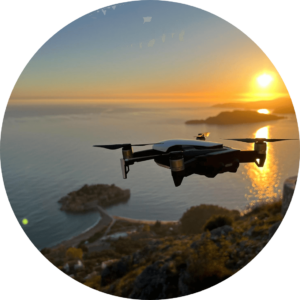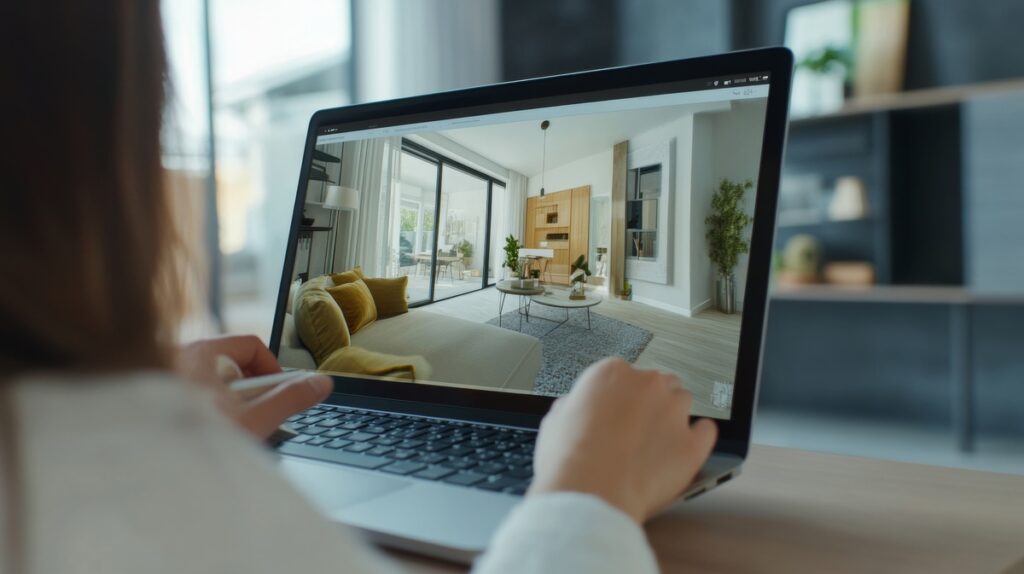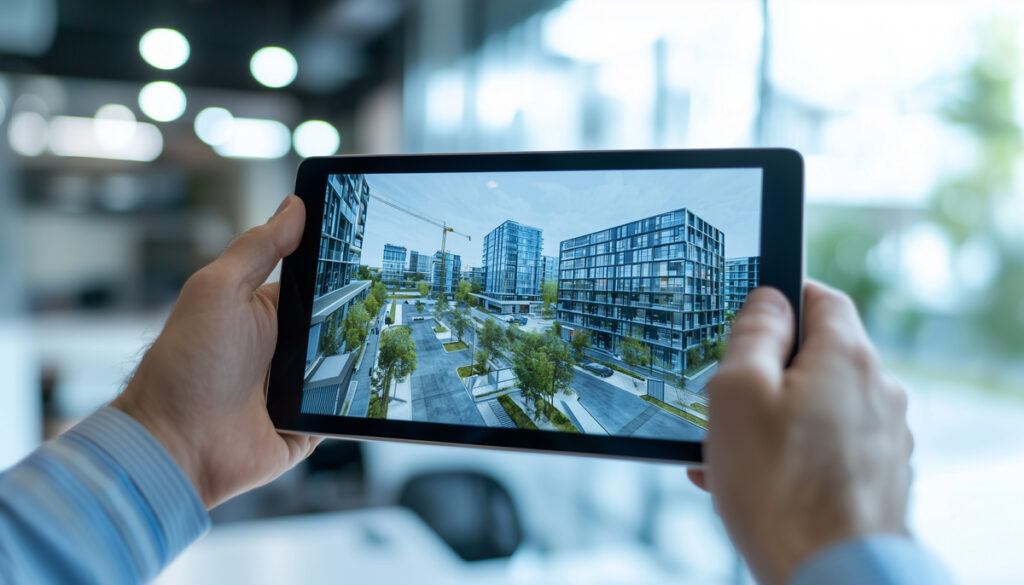3D tours in real estate offer an immersive, interactive experience that allows potential buyers to explore properties remotely with a sense of presence usually reserved for in-person visits.
These tours accurately render spaces, providing a detailed and realistic perspective of the property. Originating from simpler virtual tours in the late 1990s, where static images on basic websites were standard, the technology has rapidly evolved.
The advent of sophisticated software and hardware developments has brought 3D tours to the forefront of digital marketing in real estate.
This cutting-edge tool has gained popularity in the real estate business due to technological advancements, making it possible to view properties extensively at any time, from anywhere, enhancing accessibility and engagement during the home-buying process.
Experience the Future of Real Estate!
Ready to revolutionize your property listings? Contact Corporate Capture today to create stunning 3D tours that will set your properties apart from the competition!
The Evolution of Property Viewing
Property viewing has significantly evolved from traditional methods to incorporate advanced technology such as virtual reality, transforming the way potential buyers and renters explore real estate.
Initially, property viewings were reliant on in-person visits, where interested parties had to physically tour the premises to assess the space. This method, while effective in creating a personal connection with the property, posed limitations in terms of time, geographic accessibility, and scheduling.
To complement in-person visits, real estate agents began using 2D-floor plans and photographs, enabling clients to get a preliminary sense of a property’s layout and features. However, these images often lacked depth and context, making it challenging for viewers to visualize the actual space.
The digital age brought forth the emergence of virtual tours, which were groundbreaking at their inception. Early virtual tour technology provided a static, panoramic view of the property, allowing users to navigate through rooms with greater ease compared to traditional photos. However, these early versions were limited in their interactivity and realism.
As technology advanced, virtual tours evolved into fully immersive 3D experiences for many real estate listings. Using specialized cameras and software, 3D tours offer realistic and interactive experiences, allowing viewers to explore properties from different angles and scales and virtually walk through them in a convenient and efficient way.
Virtual tours offer innovative options not only to save time and effort but also to broaden access to global markets, revolutionizing the property viewing experience by offering a convenient, comprehensive, and lifelike glimpse into potential homes.
How 3D Tours Work
3D virtual tours in real estate leverage cutting-edge technology to provide immersive property viewing experiences. At the core of this innovation lies 360-degree cameras and photogrammetry.
These cameras capture high-resolution images from every angle within a property, while photogrammetry techniques stitch these images together, creating a seamless and interactive environment.
The captured data is then processed by software platforms designed for 3D tour creation, such as Matterport, iStaging, or Cupix. These platforms use algorithms to render the images into a navigable virtual model of the property.
Creating a 3D tour involves several key steps. First, a 360-degree camera, and often additional equipment like tripods and lighting gear, are used to capture images throughout the property. These images are then uploaded to a computer where specialized software organizes and processes them into a cohesive 3D model.
The next step involves editing and fine-tuning the model for accuracy and visual appeal. Once the tour is complete, it is integrated into real estate platforms, allowing prospective buyers to explore properties remotely. This process not only enhances the viewing experience but also expands the reach of real estate listings, making them accessible to a global audience.
Benefits of 3D Tours for Buyers
For prospective real estate buyers, online tours offer numerous advantages that transform the traditional process of property viewing. One of the key benefits is convenience, interactive features, and flexibility; buyers can tour properties anytime and anywhere from the comfort of their own home or on the go, which fits seamlessly into busy schedules.
This digital option allows for detailed exploration of different layouts and real estate listing options, providing potential buyers with an accurate depiction and a comprehensive understanding of the space. Enhanced visualization through 3D tours offers an immersive experience that closely simulates an in-person visit, enabling a detailed assessment of the spatial representation and overall flow of a property.
Furthermore, this advanced technology facilitates time and cost efficiency by reducing the necessity for multiple physical visits, allowing buyers to narrow down options more swiftly and make informed decisions in less time.
By eliminating travel and scheduling challenges, 3D tours empower buyers to focus only on the most fitting properties, thus streamlining the home-buying process significantly. The combination of these benefits not only enriches the buyer’s experience but also increases their confidence in making substantial real estate investments.
Benefits of 3D Tours for Sellers and Agents
3D tours offer a multitude of benefits for sellers and real estate agents, profoundly impacting how properties are marketed and sold. By leveraging virtual technology, 3D tours drastically expand the audience reach, making properties accessible to an international market.
This tool is particularly beneficial for attracting international buyers, who can explore properties through immersive experiences and high-quality photos in detail without the need for costly travel, just in a few hours.
Additionally, 3D tours cater to remote or busy prospective buyers, providing a convenient means to view properties at any time from anywhere, increasing the chances of capturing their interest. In other words, they’re perfect for a wider audience.
As an enhanced marketing tool, 3D tours significantly boost engagement rates, with listings incorporating them seeing much higher interaction compared to traditional ones. In a competitive market, this differentiation can be pivotal, setting properties apart from others and catching the eye of potential buyers early in their search.
Moreover, 3D tours streamline the sales process, increasing efficiency by pre-qualifying serious buyers. This method reduces the number of physical showings needed, saving time and resources for both sellers and agents while ensuring that in-person visits are reserved for genuinely interested parties.
Overall, 3D tours are a strategic asset for modern real estate practices, offering a comprehensive visual experience that traditional listings cannot match.
Transform Your Property Marketing!
See how 3D tours can change the game for your real estate business. Visit our portfolio and schedule a demo with Corporate Capture to bring your listings into the digital age!
3D Tours vs. Traditional Marketing Tools
When comparing 3D tours to traditional marketing tools like photos, the limitations of static images become apparent. Photos provide limited perspectives and often fail to convey the spatial context of a property. In contrast, 3D tours offer an interactive experience, allowing potential buyers to virtually explore the space at their own pace, providing a sense of presence that photos simply cannot.
Unlike video tours, which follow a linear path dictated by the videographer’s narrative, 3D tours enable non-linear exploration. This empowers viewers to navigate properties according to their interests, inspecting intricate details or broader layouts without constraints.
Video tours, while visually captivating, provide a controlled narrative, potentially overlooking areas of interest that a potential buyer may wish to explore more thoroughly.
In-person tours, although offering a tangible experience with real-time interaction, have their drawbacks, such as limited flexibility in scheduling and geographic constraints.
However, they allow prospects to experience the property’s ambiance, including lighting, sound, and atmosphere, firsthand. When complemented by 3D tours, these physical visits become more strategic, as prospective buyers can narrow down options and arrive better informed, making the actual viewing more efficient.
Therefore, 3D tours enhance traditional methods, bridging the gap between convenience and comprehensive property evaluation.
Types of Properties that Benefit from 3D Tours
3D tours are incredibly beneficial across a wide range of property types in the real estate market. Residential properties, including single-family homes and apartments or condos, gain significant advantages as potential buyers can explore various layouts and amenities from the comfort of their homes.
Commercial real estate, such as offices and retail spaces, utilizes 3D tours to demonstrate functionality and spatial layout, helping prospective tenants envision their business operations within the space.
Warehouses and industrial properties are also ideal candidates, as 3D tours can highlight key features like loading docks and storage capacities, which are critical points of consideration for potential clients.
Moreover, luxury and high-end listings stand to gain immensely from 3D tours as they allow real estate agents to showcase exclusive and intricate details, from opulent finishes to panoramic views, capturing the essence of upscale living. Altogether, 3D tours enhance engagement and provide a comprehensive understanding for all stakeholders involved.
Challenges and Limitations of 3D Tours
While 3D tours have revolutionized real estate, they come with challenges. High costs and limited accessibility can deter sellers, as professional equipment and software investment is substantial.
Moreover, finding skilled 3D tour service providers can be difficult, particularly in less urbanized areas. Technological barriers also exist, including the necessity for fast internet to smoothly view the tours.
This requirement can restrict potential buyers who have slower connections. Compatibility issues arise with older devices, which may not support the software or provide an optimal viewing experience.
Additionally, 3D tours, despite their sophistication, may struggle to capture every detail accurately. Certain areas of a property might be overlooked or misrepresented, potentially leading to inaccuracies. These shortcomings highlight the need for careful planning and execution when utilizing 3D tours in real estate, ensuring that the technology enhances rather than detracts from the property viewing experience.
Summary
In conclusion, 3D tours have emerged as a transformative tool in the real estate industry, offering unparalleled advantages over traditional marketing methods. By providing an immersive, interactive experience, they allow potential buyers to explore properties in-depth from anywhere in the world, thus expanding the market reach and appealing to a broader audience, including international and remote buyers.
The enhanced engagement and interaction rates that 3D tours facilitate can be a game-changer in competitive markets, setting properties apart and capturing early interest.
Despite their significant benefits, the adoption of 3D tours does present challenges, such as high costs, technological requirements, and potential accuracy issues. However, when effectively implemented, they streamline the sales process by pre-qualifying serious buyers and reducing unnecessary physical visits.
As the real estate industry continues to evolve, the integration of 3D tours represents a strategic advancement, offering a comprehensive visual experience that complements traditional methods and enhances property evaluation. By addressing the associated limitations and continually adapting to technological advancements, 3D tours are poised to remain a vital component of modern real estate practices.
Elevate Your Listings Now!
Don’t let your properties get lost in the crowd. Book a 3D tour session with Corporate Capture and give potential buyers an immersive viewing experience they won’t forget!








